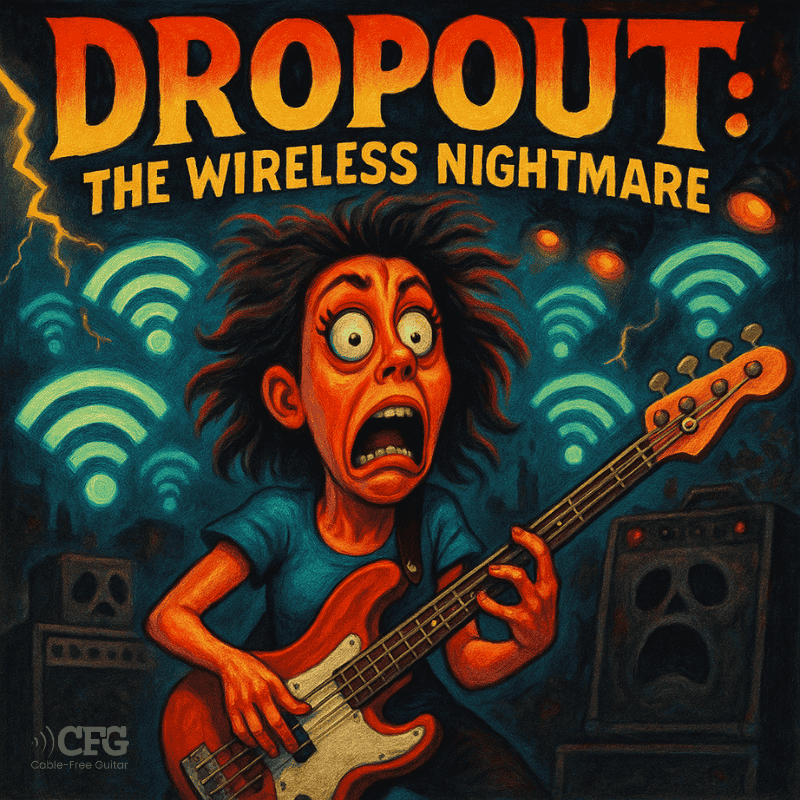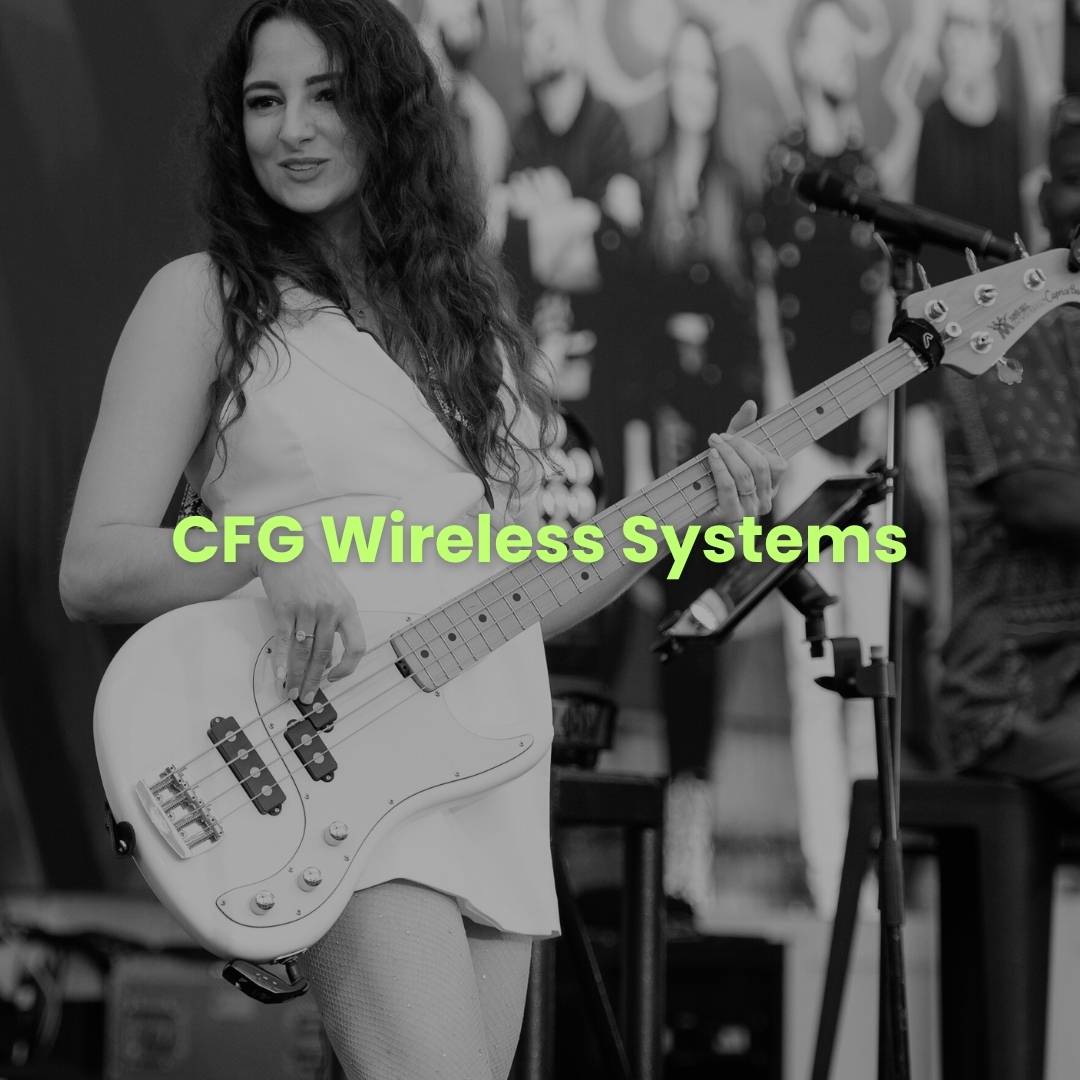If you’ve ever watched your wireless signal drop harder than your drummer’s sticks during a fill, this post is for you.
Wireless systems for guitar and bass have come a long way. Once the exclusive gear of big-touring acts with rackmount units worth more than your car, you can now jump into the wireless world for as little as 30 bucks. That’s both a blessing and—if we’re being honest—a bit of a gamble. Because while budget wireless units can be game-changers, they often come with their own backstage drama.
I’m not here to hate on affordable gear. I’ve personally rocked a $50 system on a last-minute bar gig and lived to tell the tale. But I’ve also seen one cut out mid-solo, turn my tone to oatmeal, or just... not turn on at all. That’s why we’re diving into the most common issues you can expect with budget-friendly wireless guitar systems—and exactly how to overcome them without rage-quitting and going back to a 20-foot cable.
We’ll talk dropouts, lag, tone suckage, battery disasters, weird noises, and more.
Let’s plug into freedom—but do it the smart way.

1. Signal Dropouts – AKA the Ghost in the Machine
Few things will mess with your head faster than mid-song signal dropouts. One second you’re playing your heart out, the next it’s crickets in the front row and panic in your brain. And when you’re using a $30–$150 wireless system, this is probably the most common gremlin you’ll face.
Why It Happens
Signal dropouts can be caused by a whole lineup of culprits:
- Interference from other wireless devices (especially on the crowded 2.4GHz band used by most budget units)
- Weak transmitters that just don’t have the juice to punch through walls, crowds, or even your own body (yes, you can block your own signal if the transmitter’s behind your back)
- Poor antenna design or placement — some of these units are built like toys, not tools
- And let’s not forget frequency collisions — especially if your band has multiple wireless units that aren’t playing nice together
A lot of budget systems just operate on one or two fixed channels. If someone else is on the same frequency (another guitarist, a Wi-Fi router, your uncle’s Bluetooth hearing aid), welcome to drop-out city.
How to Fix It
Here’s how to tame the dropout demon:
- Look for systems with multi frequency switching. CFG’s wireless systems, NUX, and Xvive, lets you select from multiple channels, so you can hop off a bad frequency faster than your drummer ghosting rehearsal.
- Stay in line of sight. If you’ve got your receiver jammed behind a giant pedalboard, or you’re doing backflips on stage (you maniac), the signal can struggle. Try keeping the receiver in an upright position at all times, as this makes it easier for it to receive 360° signal.
- Get your router outta the room. Wi-Fi signals, especially in the 2.4GHz range, will absolutely step on your wireless signal like a drunk guy in cowboy boots. Don’t rehearse 3 feet from your modem if you can help it.
- If you’re in a band with multiple wireless users, plan your channels in advance. Assign each person a different channel and do a quick test before your set starts.
- Bonus move: Always keep a short guitar cable in your gig bag. If all else fails, you can plug in, finish the song, and troubleshoot later. Hero move.
CFG’s lineup of wireless systems are designed with all this in mind. Multiple channels, easy channel switching, and strong-as-heck transmitters mean you won’t have to sweat it when you’re on stage or across the room.

2. Latency – The Lag That Makes You Doubt Your Groove
You ever hit a note, and it feels like it took the scenic route before coming out of your amp? That’s latency — the barely noticeable (or sometimes painfully noticeable) delay between when you play and when you hear your playing. In a high-stakes gig or even a focused home session, it can throw your timing off just enough to make you feel like your internal metronome got drunk and fell down the stairs.
What’s Going On
All wireless systems introduce some latency. That’s the delay caused by converting your analog guitar signal to digital, transmitting it wirelessly, and then converting it back to analog before it hits your amp or interface.
The trouble starts when latency gets into the 10ms+ range — which, unfortunately, is common in some budget systems. It might not sound like much on paper, but in real life? It’s like trying to play along with a delay pedal set just wrong.
And if you’re a fast picker, funk-chopper, or anyone who lives and dies by tight rhythm? You’re gonna feel it like a punch in the groove.
Fix the Funky Delay
Here’s how to reclaim your timing:
- Stick to systems with sub-5ms latency — CFG’s models clock in under 4ms, which is practically imperceptible to the human ear (and even to your drummer). That's faster than your average human reaction time and won't mess with your playing at all.
- Test your full signal chain, not just the wireless system. If you’re running digital pedals, modelers, or certain amp sims, they might add a few ms of lag too. Stack enough of those up, and even a good wireless rig can sound off.
- Try the latency test trick: Play tight 16th notes through your wireless system and record yourself. Then compare that to a wired take. If the wireless take sounds like you’re chasing yourself — yep, latency’s your issue.
- Beware of off-brand budget systems with no latency specs. If the manufacturer won’t list their numbers, it’s probably not great news.
Bottom line: latency is like cholesterol. You want the good kind (almost none), and you want it managed. CFG systems keep it low, tight, and gig-ready, so your playing stays locked in, no matter how fast your fingers fly.

3. Tone Suck – When Your Killer Tone Takes a Nosedive
You’ve spent years (and probably way too much money) dialing in that perfect tone — pedals stacked just right, tubes humming like angels, EQ carved like a Thanksgiving turkey. Then you plug in your new wireless unit, strum a chord, and… meh. Where’d the sparkle go? Where’s that punch? Did someone throw a wet blanket over your amp?
Welcome to the land of tone suck, population: anyone using a wireless system that wasn’t built with your tone in mind.
Why It Happens
Budget wireless systems often cut corners in places you don’t want them to, like:
- Cheap analog-to-digital converters that flatten your signal’s dynamic range
- Over-compression to “help” battery life or reduce bandwidth needs
- Low headroom resulting in distorted or squashed transients, especially if you play active pickups or high-output humbuckers
- And sometimes, just straight-up poor signal fidelity — the audio equivalent of sending your tone through a fax machine
Tone suck is especially obvious if you A/B your wireless with a high-quality cable. One sounds like you, the other sounds like a filtered Instagram version of you: slightly fake and lacking depth.
Restore the Mojo
Here’s how to keep your tone fat, rich, and fully snackable:
- Invest in a full-bandwidth system. CFG’s wireless systems deliver crystal-clear audio across the entire guitar frequency range — no roll-offs, no compression artifacts, just your tone, clean and mean.
- Look for systems with 24-bit / 48kHz (or better) conversion. That’s the sweet spot for preserving both clarity and warmth. Anything lower than 16-bit/44.1kHz should be a red flag — even cassette tapes did better.
- If your rig starts sounding dull, try bumping the upper mids (around 1.5–2kHz) slightly on your amp or EQ pedal. It can help compensate for minor roll-off.
- Avoid stacking digital gear. A cheap wireless system + a cheap digital reverb + a cheap amp sim = audio mush. Pick your digital battles.
- Use a quality buffer if needed. Some systems drop impedance or struggle with certain pedals — a buffer up front (or a solid preamp pedal) can help recover lost punch.
And of course, don’t forget: CFG’s wireless systems are all tested for zero tone suck. We don’t sell anything we wouldn’t personally gig with — and believe me, we’re tone snobs in the best way.

4. Short Battery Life – It Dies So Fast, It Might Be a Romance
There’s nothing like confidently strapping on your guitar, wireless transmitter flashing green, crowd vibing… and then, silence. Your signal just ghosted you mid-song like a bad Tinder date. Spoiler alert: it’s not your tone or your playing—it’s your battery, and it peaced out hard.
The Culprits
Budget wireless units often ship with the battery equivalent of a gas station flashlight — sure, it technically works, but don’t expect endurance:
- Tiny internal Li-ion batteries that top out at 2–3 hours
- Zero power management — no auto-sleep, no low-power mode, nothing
- Fake runtime specs from companies that tested under “ideal lab conditions” (translation: not plugged into anything)
- And let’s not forget the dreaded “I forgot to charge it” issue — which hits harder when there’s no charge indicator to warn you
In other words, that $40 wireless setup might work great — if you’re playing a single short set… and you remembered to charge it... and Mercury isn’t in retrograde.
What You Can Do
Here’s how to keep your signal alive longer than your last relationship:
- Choose systems with real, tested battery life. CFG’s systems give you a solid 6–8 hours of reliable playtime. No BS marketing numbers—just tested results by real musicians.
- Look for charge indicators. CFG systems feature clear LED indicators that actually tell you when it’s time to plug in—not when it’s already too late.
- Recharge smart: Always top off before a gig. Most CFG systems fully charge in under two hours via USB-C (no weird proprietary chargers to lose at practice).
- Use a portable USB battery pack if you’re on tour or doing back-to-back gigs. Bonus: CFG units can often run while charging—try that with your random eBay unit.
- Don’t use janky third-party batteries. If your unit runs on replaceable AAAs, go with name-brand rechargeables. Trust me, those sketchy Amazon-brand “high-capacity” ones lie harder than a cover band’s bio.
Battery life isn’t glamorous, but it’s the difference between finishing a set like a pro or awkwardly switching to a backup cable while the rest of the band covers for you. CFG’s gear is built with gigging musicians in mind—long runtime, quick charging, and honest battery specs.

5. Build Quality – Feels Like a Toy, Breaks Like a Toy
You ever pull a budget wireless unit out of the box and think, “Huh… this feels like something that came free with a cereal box?” Yeah, you’re not wrong. A lot of budget systems look slick online, but in real life, they’re flimsier than your band’s commitment to practicing on Thursdays.
When Plastic Isn’t Fantastic
Here’s where the weak spots usually show up:
- Flimsy plastic enclosures that crack when dropped or even squeezed too hard
- Loose ¼” jacks that wobble in your guitar’s input like a toddler in dad’s boots
- Rotating joints that get floppy over time and refuse to stay in position (usually right before a solo)
- Buttons that feel like they came from a dollar store remote — you know, the ones that either don’t click or stick like peanut butter
And don’t get us started on the clip-on belt units that snap the first time you bend over to adjust your amp. Spoiler alert: real stages and rehearsal rooms are not gentle environments.
Go Rugged or Go Home
You don’t need to pay $400 for bulletproof wireless. You just need gear that doesn’t fall apart at the sight of a stage.
Here’s what to look for:
- Metal-reinforced plugs and connectors – CFG systems feature durable jacks that won’t loosen or strip after a few uses
- Secure hinge design – no limp rotating heads that slowly spin out of position like a sad desk fan
- Non-slip coating – because nothing says “cool” like watching your wireless transmitter rocket across the stage mid-spin
- Solid construction inside and out – CFG models are player-punched and gig-tested, not just factory assembled and wish-you-luck’ed
Quick fix hack: If your current system has a loose plug or rotating jack, a tiny strip of gaffer tape can keep it locked in place short-term. But if you’re taping your gear together before every show, maybe it’s time to level up.
Bottom line? If it feels like a toy, it’s gonna act like a toy. CFG systems are built for musicians who actually gig, sweat, and occasionally drop stuff. (Hey, it happens.)

6. Limited Range – AKA the “Don’t Leave the Stage” Clause
You fire up your wireless system, take a few steps away from your amp, and BAM — signal gone. Turns out your wireless range is about the same as your cat’s attention span: short and easily disrupted. Not ideal when you’re trying to shred from the crowd or just walk to your pedalboard without fear.
What’s Limiting You
Here’s why budget wireless systems sometimes choke when you try to move:
- Low transmit power – A lot of cheap units just don’t have the wattage to send your signal more than 30 feet, especially through walls or bodies (yep, your body is a walking signal blocker).
- Weak internal antennas – Some designs prioritize looking slick over working well. That flat plastic shell? It’s not doing your signal any favors.
- Poor PCB layout – Bad internal circuit design can cause signal loss even before the signal leaves the unit.
- Marketing lies – You’ll see claims like “100-foot range” but what they mean is “100 feet in an empty parking lot with no Wi-Fi, Bluetooth, or air.”
Now toss in stage lights, wireless mics, in-ear systems, and other players using similar gear, and that “100-foot” promise turns into a 10-foot panic zone.
Stretch Your Legs
To actually use your wireless without fear, here’s what you need:
- Look at actual tested range, not just advertised range. CFG’s systems are tested in real-world conditions — crowded stages, practice rooms, and bar gigs. We don’t just measure it in empty fields.
- Line-of-sight matters. If your amp’s behind a wall, a stack, or your bass player’s massive calves, your signal might struggle. Try to keep the receiver within direct view when possible.
- Make sure the receiver is oriented correctly. It's not just about where you place it, but how it's positioned. The body of the receiver should be pointing upwards, whether it’s on the floor, on your amp, or duct-taped to a mic stand. That vertical orientation gives you the best possible line-of-sight for signal strength.
- Don’t block your transmitter. Strap it to your front hip or guitar strap instead of your back pocket — especially if you’re doing the ol’ stage wander.
- If you play outdoors, test before the show. Outdoor gigs seem easier for wireless, but weather, distance, and random interference can be brutal. Bring a backup cable just in case.
CFG systems don’t just “look pro” — they actually perform like pro gear, even when you’re 40 feet out in a crowd, soloing on a bar table (been there, done that, didn’t lose signal).

7. Compatibility Clashes – Doesn’t Play Nice with Your Rig
So you’ve got your shiny new wireless unit. You plug it in, hit the power, and… nothing. Or worse, your tone suddenly sounds like it’s being piped through a tin can. Turns out, not all wireless systems get along with all guitars, amps, or pedal setups. Compatibility clashes are the silent killer of many a wireless dream.
Problems That Arise
- Output too hot or too weak – Some wireless units don’t output at standard instrument level. They’ll either hit your pedals too hard and cause clipping, or come in so soft your amp thinks you’re whispering.
- Impedance mismatch – Especially a problem with vintage pedals or tube amps that expect to “see” a certain load from the guitar. If your wireless doesn’t deliver it, tone and dynamics go wonky.
- Physical fit issues – Strat jack cups, recessed jacks on certain basses, or rear-facing Tele inputs can all reject budget wireless plugs like a picky cat. Some budget systems have rigid plugs that won’t flex or swivel, making them borderline unusable for certain guitars.
- Pedalboard funkiness – Some systems hate being run into buffered pedals, or don’t play nice at the front of a digital chain.
Smooth the Connection
Here’s how to make your wireless system play nice with your rig:
- Use a short patch cable or adapter if needed. If your wireless won’t fit into your guitar comfortably, a straight or right-angle ¼” adapter (or patch cable) can save the day. CFG systems are designed to avoid most of these issues — but we know weird guitar builds exist, so plan ahead.
- CFG units come with rotatable plugs, so you can twist and aim the transmitter no matter where your guitar’s input jack is hiding. Top-mounted Strat jack? Rear-loaded bass input? No problem.
- Watch for output level specs. CFG wireless systems are calibrated to standard instrument levels, meaning they won’t overload your fuzz or underwhelm your amp’s input.
- Consider a buffer. If you notice tone degradation after your wireless hits your pedalboard, especially on long chains, throw a good buffer pedal early in the signal path to keep everything tight and punchy.
- Try it out before show day. Always run a full rehearsal with the wireless in your actual gig rig. You’ll catch any incompatibilities before you’re mid-set staring at your board wondering why your fuzz pedal sounds like a kazoo.
CFG gear is designed to work across all major guitar and bass setups, from vintage single coils to active 5-string basses. We’ve tested it, gigged it, and tweaked it — so you don’t have to.

8. Channel Chaos – Everyone’s Wireless, No One’s Happy
So you show up to band practice and suddenly you’re hearing someone else’s guitar through your amp. Or worse, you’re all stepping on each other’s signals and everything’s cutting in and out like a cursed radio. Welcome to channel chaos, where everyone’s wireless, but nobody wins.
What Happens
Here’s what’s probably going on:
- Too many players on too few channels – Budget systems often only offer 1 or 2 channels, and if you’ve got three guitarists, a bass player, and maybe a wireless mic or two? Good luck.
- No manual channel selection – If your system always powers on to the same default channel, guess what… so does everyone else’s.
- Random pairing conflicts – Especially bad with “auto-pairing” systems that don’t give you any say in what channel they grab.
You think it’s bad at practice? Try a bar gig where five other bands are rotating through the same stage all night. You’ll be lucky if your guitar even finishes the first chorus.
Herd the Frequencies
Here’s how to keep your wireless rig from going full Lord of the Flies:
- Get a system with multiple selectable channels. CFG systems give you plenty of channels to work with (4, 6, and 7)— and most importantly, let you pick which one you’re on.
- Coordinate with your bandmates. I know it sounds like a group project, but take five minutes before rehearsal or a gig to make sure everyone’s on a different channel. It’ll save you a world of pain.
- Color-code or label your units. CFG gear comes with clear channel indicators, but it never hurts to slap a piece of tape on there with your name or number — especially if you’re in a multi-guitar setup or gear-sharing situation.
- Test your channel before the show starts. Just because it worked during soundcheck doesn’t mean it’ll work once the house fills up with sweaty people and smartphones. Do a quick pre-set check once the room is full.
- And yes, always have a backup cable. Channel chaos can strike even the best setups. Having a cable ready to go is the pro move.
CFG’s multi-channel systems are designed to eliminate the stress of competing wireless signals. You get control, stability, and the kind of peace of mind that makes you not want to throw your gear across the room.

9. Latent Weirdness – Random Pops, Hisses, or Crackles
You’re playing along, everything feels great, and then—pop. Crackle. A hiss that won’t quit. No, your amp isn’t haunted (probably). What you’re hearing is latent weirdness, and it’s one of the hardest wireless issues to pin down. It comes and goes. It’s never consistent. It might only happen on one note. It might only happen when someone walks by with a phone. It's like your wireless rig has stage fright.
Sounds from the Abyss
Here’s where that funky noise might be coming from:
- EMI (Electromagnetic Interference) – Think cell phones, stage lighting, wireless routers, or even neon signs.
- Poor shielding – Cheaper units often cut corners on internal shielding, which means they’re wide open to interference.
- Crappy soldering or PCB layout – Bad design can cause noise bleed or even microphonic behavior from components.
- Wacky grounding issues – Especially when your wireless system interacts poorly with your amp or pedalboard’s power supply.
- Low battery voltage – A dying battery can cause all sorts of weirdness, from hiss to signal clipping, before it dies completely.
Sometimes it sounds like bacon frying. Other times it’s like someone’s flipping a light switch inside your amp. Either way, it’s unacceptable.
Clean It Up
Here’s how to exorcise those audio demons:
- Test in isolation. Unplug your wireless from your rig and run it into a clean amp. If the noise disappears, it’s a rig issue, not the wireless. If the noise stays, bingo.
- Use quality wireless gear with proper shielding. CFG’s models use improved internal shielding and thoughtful circuit layout to keep the weirdness out.
- Move away from interference sources. That big LED lighting rig above your head might look cool, but it could be trashing your signal. Step away and see if the noise goes with it.
- Check power supplies. Wall-warts and daisy-chained pedal power can introduce noise. Try using isolated power.
- Consider a noise gate. If all else fails, a well-placed noise gate pedal can clean up low-level hiss or hum without wrecking your tone.
CFG gear is built to be quiet when it should be — even in sketchy environments with tons of potential interference. So you can focus on your tone, not your tech support skills.

The CFG Way – Why Our Wireless Gear Slaps While Others Just Slap Together
We’ve walked through the full rogues’ gallery of budget wireless issues: dropouts, lag, tone suckage, battery betrayal, build disasters, limited range, rig incompatibilities, channel cage matches, and random sonic spookiness.
It’s a miracle anyone uses wireless at all, right?
But here’s the truth: you don’t have to live with this nonsense. Wireless freedom can be glorious — if you use gear that’s actually designed for musicians by people who know what makes gear gig-worthy.
Cable Free Guitar (CFG) wireless systems are built with everything we just covered in mind. That means:
- Rock-solid signal reliability with multiple channels and real-world-tested range
- Super low latency that keeps your timing tighter than your singer’s new compression socks
- Tone integrity that respects your rig — no muffling, squashing, or unwanted “vintage AM radio” vibes
- Legit battery life with honest specs, fast charging, and smart power management
- Rugged design that doesn’t crumble under stage use, travel, or occasional drops (because let’s be real)
- Player-friendly features like rotatable plugs, clear sync indicators, and full compatibility across guitar and bass setups
We don’t sell gear that might work. We only stock systems that we’d happily use on stage, in studio, or at 2am in a sketchy dive bar with questionable wiring and a noise floor that sounds like bees in a blender.
So if you’re tired of babysitting your wireless system or gambling with every power-on, make the switch to something that just works. Check out CFG’s full wireless collection here — and get ready to move, shred, and solo with no strings attached. (Well, one string. The virtual kind.)
Final Thoughts – Cut the Cord, Keep the Rock!
Going wireless doesn’t have to mean giving up reliability, tone, or your sanity. It just means choosing wisely — and avoiding the trap of “cheap and cheerful” systems that are more cheap than cheerful.
Whether you’re gigging every weekend, recording at home, or just sick of tripping over your cable for the thousandth time, wireless can be the upgrade you’re looking for. Just don’t settle for the bare minimum.
And remember: friends don’t let friends gig on $20 specials with names you can’t pronounce.






